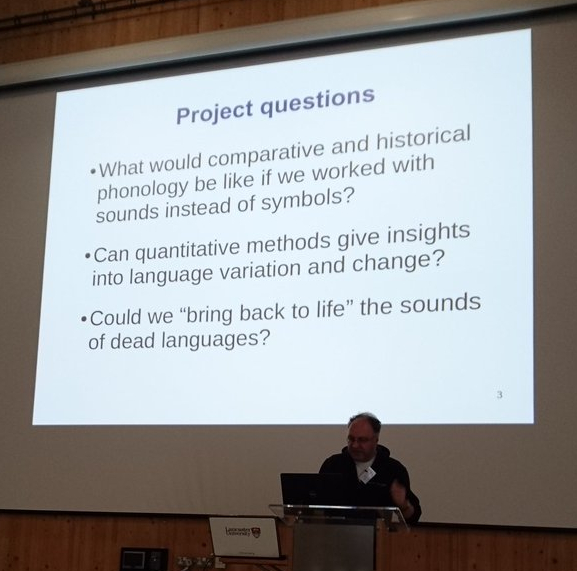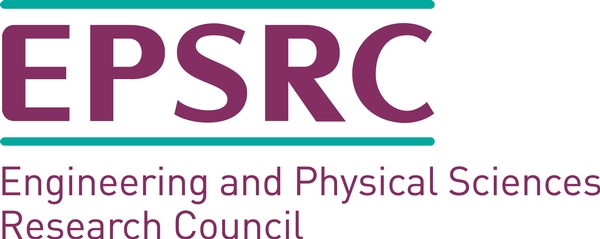


People
Papers
Presentations
Audio demonstrations
Indo-European digits database
Events/activities/blog
@ancientsounds@mastodonapp.uk
17 November 2016. Symposium on Statistics, Language Change and Variation
Thursday 17th November, 1 p.m.
Centre for Linguistics and Philology, Walton St.
This symposium brought together a local network of researchers and visitors working in various disciplines, with a common interest in quantitative modelling of language evolution, variation and change, and their causes and impediments to change.
Registration is free. If you'd like to attend, please contact enquiries@phon.ox.ac.uk, preferably by FRIDAY 11TH NOVEMBER
1:00 Buffet lunch - let us know your dietary requirements
1:30 Welcome and introductions
1:45 - 5:45 Talks, not yet in order of presentation:
John ASTON, Statistical Laboratory, Cambridge
Title tbc
Alex BOUCHARD-CÔTÉ, Department of Statistics, University of British Columbia, currently visiting Oxford
Title tbc
John COLEMAN, Phonetics Laboratory, Oxford
Estimating the rate and direction of sound changes
Geoff NICHOLLS, Department of Statistics, Oxford
Title tbc
Inés PEÑA NOVAS, Linguistics, CUNY, and & Marco ARCHETTI, School of Biological Sciences, UEA (Norwich) Phonetic robustness and the evolution of phoneme usage
Janet PIERREHUMBERT, Oxford e-Research Centre and Faculty of Linguistics
Modelling the spread of arbitrary innovations in language
Davide PIGOLI, Statistical Laboratory, Cambridge
Spatial modeling of sound change: dialectal variation in the spoken part of the British National Corpus
5:45 Open session, final thoughts and questions
6:00 Glass of something nice
6:30 Finish
25 July 2016. Local TV channel Cambridge TV did a nice piece about the project, focusing on the statistics and starring our photogenic colleagues Davide Pigole and Shahin Tavakoli.
20
July 2016. Dailymail.com carried an
article which was a
reasonable paraphrase of the Cambridge University
news article.
19
July 2016. Cambridge University
Office of External Affairs and Communications published a
nice news
article about our project, "Time Travelling to the
Mother Tongue". This piece was widely copied (sometimes as
a slightly garbled paraphrase) on various online news
sites.
16 July 2016. LabPhon15, Cornell University, Ithaca, USA. "Acoustic-phonetic modelling of historical and prehistoric sound change" Abstract Poster
9 May 2016. 5:15, Taylorian Institute, Oxford, Graduate Linguistics Seminar: "Acoustic modelling of historical and prehistoric sound change"
30 March-1 April 2016. "Modelling the changing rate and direction of historical and prehistoric sound changes." British Association of Academic Phoneticians, University of Lancaster.

12
January 2016. The
AHRC Science in Culture Innovation Award that
has been supporting J. Coleman's research time
for the past year has now ended. The summary
final report is available from here.
Even so, the Ancient Sounds research goes on ...
(and on and on, we hope!)
8 January 2016.
One-day teach-in in
Oxford on acoustic modelling of sound change. Details here.
All the materials (presentations, software, data etc.)
from the workshop can be downloaded from here.
25-29 November 2015. London Mathematical Society at the Science Museum, London
12 November 2015. "Statistical Acoustic-Phonetic Historical Linguistics: a short introduction". Cambridge Language Sciences annual symposium. Slides (without audio) are here, and a nice video recording is here:
23 October
2015. Previously
I posted demo of "five" from (Lithuanian) "penki". But
PIE has *penkwe, not penki. So here done better: https://www.phon.ox.ac.uk/jcoleman/five-from-penkwe.mp3 …
Starting to fill new table of Indo-European digit sounds at http://www.phon.ox.ac.uk/jcoleman/ancient-sounds-database.html … New tokens of *treies, *ksweks, quinque and Ancient Gk, and *penkwe, *septm (wrong stress, but hey), quattuor (hybrid of Ladin kwater and Welsh pedwar, maybe too prominent). Comments +/- welcomed.
2 October 2015. A 78 rpm record of Sogdian from the Sorbonne Archive de la Parole, 1911-1914 [Bibliotheque nationale de France]: http://www.phon.ox.ac.uk/jcoleman/chant-sogdien.wav …
Here's the official
link: [Archives de la parole]. Langue sogdienne : [énoncé de
syllabes] : [chant] http://gallica.bnf.fr/ark:/12148/bpt6k128134q/f1.media …
My guess is that it could be a
liturgical chant.
24 September 2015. For slides and audio I gave at the British Science Festival or Oxford Alumni Weekend, look here: http://www.phon.ox.ac.uk/jcoleman/ancient-sounds-presentations.html … (NB big file)
22 September 2015. Great thing about acoustic (spectral) modelling of sound change is that you can quantify the rate and perhaps direction of change. At what rate did English "one" change from Old to Middle to Modern English? From 34 to 122 microradians per year.
8 September 2015. My university press office ran a blog post about the project today: http://www.ox.ac.uk/news/arts-blog/what-did-words-used-sound
1 July 2015. Balochi for "three" is [se:], from *tre(yes) via *te:. In this demo, [te:] is from Sindhi: http://www.phon.ox.ac.uk/jcoleman/Balochi-se-from-tre.wav … I'm quite pleased with the s-to-t transformation in this example.
9
June 2015. tre(ye)s has lost final s at least
3 times: *treyes > PGer tre, Latin tres > Ital tre, Iberian
Sp tres > American tre http://www.phon.ox.ac.uk/jcoleman/treis-to-tre.wav … We model the
loss of final -s by a kind of fade-out rather than an
all-or-nothing deletion. This gives an intermediate stage tres
> treh.
From Proto-Indo-European *dwoH to (Modern) Sindhi ɓə: http://www.phon.ox.ac.uk/jcoleman/PIE-dwoH-to-Sindhi-buh.wav … (Not sure how convincing this one is; maybe we can improve it.)
8 June 2015. dw > b (in eg *dwoH) in a number of I-E languages: Lycian kbi, Avestan bae, bitya, Latin bi-, bis, and Sindhi http://www.phon.ox.ac.uk/jcoleman/DUO-xlc-PK-SND-kbi-U0012-M0039-1P.wav …
tw > p in Ossetic tsuppor (from *kʷetwóres) http://www.phon.ox.ac.uk/jcoleman/QUATTUOR-ira-oss-RU-SE-tsuppor-U0012-F0017.wav …
26 May 2015. "Three" comes from Proto-Indo-European "*treyes". Not from Spanish "tres", but that's the nearest I've got. Listen: http://www.phon.ox.ac.uk/jcoleman/three-from-treis.wav. Here's the MP3 version: http://www.phon.ox.ac.uk/jcoleman/three-from-treis.mp3 …
25 May 2015. "One" comes from Proto-Indo-European *oinos, via Middle English "oon", Anglo-Saxon "an", Germanic "oin(s)". Listen: http://www.phon.ox.ac.uk/jcoleman/one-from-oins.wav …
"One" from "oin(s)", MP3 format: http://www.phon.ox.ac.uk/jcoleman/one-from-oins.mp3 …
Previously [12th May] we generated a continuum of sounds from "two" to "twa" and vice-versa. Now, we follow "two" all the way back to Proto-Indo-European *dwo(H). WAV: http://www.phon.ox.ac.uk/jcoleman/two-from-dwo.wav … MP3: http://www.phon.ox.ac.uk/jcoleman/two-from-dwo.wav.mp3 …
“Nine” is from
Proto-Indo-European *h1newh1m (әnewәm) via [niin],
[neɣn] Listen: http://www.phon.ox.ac.uk/jcoleman/nain-from-neGn.wav … or http://www.phon.ox.ac.uk/jcoleman/nain-from-neGn.mp3 ….
20 May 2015. English "ten" comes via tene, teihen from Proto-Indo-European *dekmt (my nearest recording is Lithuanian [dešmt]): http://www.phon.ox.ac.uk/jcoleman/ten-from-deshmt.wav …
18 May 2015. "Eight" came from Proto-Indo-European *Hokto, via changes something like this: http://www.phon.ox.ac.uk/jcoleman/eight-from-okto.wav … (MP3 version http://www.phon.ox.ac.uk/jcoleman/eight-from-okto.mp3 …)
15 May 2015. "Eight" comes
from "aehta" (but I ignore the final vowel for now): http://www.phon.ox.ac.uk/jcoleman/eight-from-aeht.wav …5.
15 May 2015. "Four" comes from Anglo-Saxon "feower": http://www.phon.ox.ac.uk/jcoleman/four-from-feower.wav …
15 May 2015.
"Five" comes via fif, fimf, pemp from Proto-Indo-European *penkwe.
Lithuanian penki is nearest living word. Listen: http://www.phon.ox.ac.uk/jcoleman/five-from-penki.wav …
12 May 2015. Simulating the derivation of Modern English "two" from Anglo-Saxon "twa": http://www.phon.ox.ac.uk/jcoleman/two-from-twa.wav … Or if you prefer going forwards in time from Anglo-Saxon "twa" to Modern English "two": http://www.phon.ox.ac.uk/jcoleman/twa-to-two.wav …
1 April 2015.
For #WhanThatAprilleDay15, we made a "Sonic
Time Machine": http://www.phon.ox.ac.uk/jcoleman/sonic2.html … to
show Anglo-Saxon pronunciations (or something close to them)
that survived until quite recently in various German dialects.
14 January 2015. AHRC Science in Culture Innovation Awards meeting, London. My presentation is available under "Presentations" (see link to the left).

